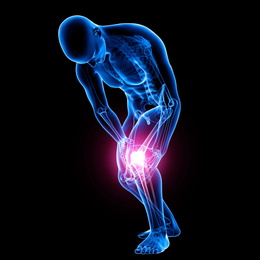Hip and knee pain occurring together is an extremely bothersome condition that can badly affect the normal activities of the body like walking, standing, etc. This article discusses the causes of this condition and possible treatment options for the same.

The knee joint and the hip joint are two of the largest joints of our body. They are located at the two ends of the thigh bone. These two joints function together to provide support to the entire body weight. They are also responsible for maintaining the mobility of our body. When there is some kind of pressure on the hip joint, then it is going to affect the knee joint. On the other hand, any knee disorder will have an impact on the hip joint. The intensity of pain in the knee and hip region often varies from mild to severe depending on the underlying condition.
Causes
There are so many health conditions that can give rise to painful hip and knee. Some of the commonly found causes are as follows:
Muscle Strain
Both the hip as well as the knee joints consist of muscles. These muscles may get strained or pulled if they get overworked, which in turn leads to sharp pain in these areas. If one gets pain from running, then the probable cause behind it is muscle strain. This occurs mostly when a person is indulged into a strenuous physical activity without proper warming up of the muscles.
Bone Fracture
If the bones present in the hip and knee get broken, a sharp pain can be experienced. Fracture in these bones can occur due to trauma like a bad fall. Elderly people tend to get bone fractures as they tend to become fragile with aging.
Pregnancy
Knee and hip pain during pregnancy is mainly triggered by change in the body structure. The growing size and weight of the uterus puts an additional amount of pressure on the knees. Moreover, the muscles of the hip area also get strained as the abdominal muscles are stretched excessively.
Osteoarthritis
On one end of the thigh bone is the hip joint, which has a ball and socket structure, while the other end is the knee joint that acts like a hinge. Both these joints consist of soft tissues known as cartilage that facilitate smooth movements of the joint. As we grow old, this cartilage wears out and the bones of the joint rub against each other. This condition of degeneration of cartilage is osteoarthritis, which make the joints stiff and painful. This is quite commonly found in elderly people.
Bursitis
This is a condition where a dull pain is felt around the hip bone and knee cap. This happens due to inflammation of bursa, a fluid-filled sac present in the hip and knee which provides cushioning to the bones and joints of these areas. Bursitis can be characterized by pain in the hip and knees at night, which tend to get aggravated with particular sleeping positions.
Treatment
The treatment is based upon the causes of the pain. However, the first thing that needs to be done when one is suffering from this kind of pain is to take proper rest. It will help ease off the muscle strain. Restricting physical activity can also prevent the pain from getting worse. Application of ice can have a soothing effect on the pain and swelling. Pain killers can be taken only after consulting a physician. Pregnant women can apply heat or opt for therapeutic massage to loosen up the muscles. Cast can be used to heal the fractured bones. Once the pain subsides, physical therapy and muscle strengthening exercises can help get rid of the problem completely. Osteoarthritis patients may have to undergo joint-replacement surgery to cure the condition.
Hip and knee pain can be prevented to a great extent if proper body weight is maintained, thereby taking the pressure off from the lower part of the body. Regular exercises can keep the muscles of these areas in strong and flexible state, which in turn will prevent any form of injury. It is also very important to stretch the muscles with warmup exercises before any strenuous activities, like running, to prevent any damage to them.
Disclaimer:
This Buzzle article is for informative purposes only, and should not be used as a replacement for expert medical advice.


 The knee joint and the hip joint are two of the largest joints of our body. They are located at the two ends of the thigh bone. These two joints function together to provide support to the entire body weight. They are also responsible for maintaining the mobility of our body. When there is some kind of pressure on the hip joint, then it is going to affect the knee joint. On the other hand, any knee disorder will have an impact on the hip joint. The intensity of pain in the knee and hip region often varies from mild to severe depending on the underlying condition.
The knee joint and the hip joint are two of the largest joints of our body. They are located at the two ends of the thigh bone. These two joints function together to provide support to the entire body weight. They are also responsible for maintaining the mobility of our body. When there is some kind of pressure on the hip joint, then it is going to affect the knee joint. On the other hand, any knee disorder will have an impact on the hip joint. The intensity of pain in the knee and hip region often varies from mild to severe depending on the underlying condition.